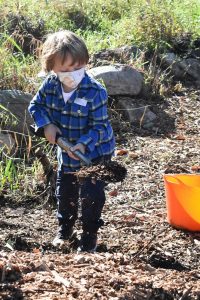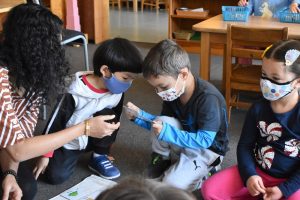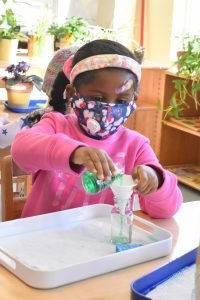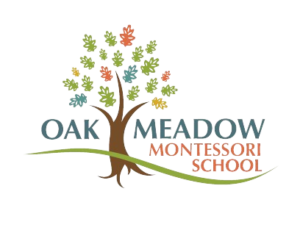Children’s House: pathway to independence and self-confidence
 Watching our students in Children’s House busily engaged in work shows the unique value provided by our early childhood program. Children are given a lesson on each “work” that is available in the classroom. The work is carefully arranged on a tray and placed on the shelf. During work time, children can choose the specific work that interests them from the shelves. A child will work on a material (at a desk or on a mat on the floor) until the child feels they have finished. They then put all of the materials back on the tray, and place it back on the shelf, selecting a new material to work on next. Work cycles occur every day. Sometimes children work individually, sometimes they work together in small groups. What is constant, however, is a classroom characterized by self-directed student activity, where every student is engaged in learning a chosen material that is also appropriately challenging.
Watching our students in Children’s House busily engaged in work shows the unique value provided by our early childhood program. Children are given a lesson on each “work” that is available in the classroom. The work is carefully arranged on a tray and placed on the shelf. During work time, children can choose the specific work that interests them from the shelves. A child will work on a material (at a desk or on a mat on the floor) until the child feels they have finished. They then put all of the materials back on the tray, and place it back on the shelf, selecting a new material to work on next. Work cycles occur every day. Sometimes children work individually, sometimes they work together in small groups. What is constant, however, is a classroom characterized by self-directed student activity, where every student is engaged in learning a chosen material that is also appropriately challenging.
This week, during my visit to all three Children’s House classes, I saw so much learning taking place.
Children receive an amazing breath and depth of curriculum. The materials are each carefully curated to represent a rich curriculum offered to our students. There’s a practical life skills curriculum that includes self care, care of the environment, and respect for others. There’s a sensorial curriculum where students learn sorting, matching, and sequencing. Children receive rich language experiences with direct phonetic practice. The math curriculum allows students to use real, three-dimensional, multi-sensory objects to concretely see and feel deep math concepts, which will help them better understand the more abstract concepts and formulas when they are older. On top of this, they learn geography, history, science, art, music, Spanish, nature, movement, and the importance of diversity and inclusion in the cultural curriculum.
 Students learn to work independently on work of their choice. During my visit this week, I observed students focused on the materials, engaged, completely independently of the teacher:
Students learn to work independently on work of their choice. During my visit this week, I observed students focused on the materials, engaged, completely independently of the teacher:
- Four students are working together. They are making a coin book, using a completed coin book as an example of what their book will look like. They are each cutting out different coins–pennies, nickels, dimes, quarters. Then they are pasting each one onto a page that correctly identifies the coin and its value. The final product is their own coin book with all of the coins correctly identified.
- A boy has what looks like a wooden puzzle with an abstract design. He has to match shapes in order for the piece to fit on the board. He looks at the board and concentrates. I can see him thinking about what shape he needs to find. He searches through the basket full of shapes to find just the right one, and puts it on the board.
- A girl is using a plastic hammer to hit pegs through a hole that fits that diameter. Later she selects a material where she has to put different types of screws, of different shapes, into their proper holes, using a plastic screwdriver.
- A girl is pouring glass beads from a thermos into a cup, being careful to not spill any of the beads. When she is finished, she gets a material that involves using a small broom and scoop to sweep up glass beads from a surface, working carefully to get all of the glass beads onto the scoop.
- A student is writing letters by tracing over an outline on the page. Another student is making rubbings of different letters, by placing paper on top of a rough textured letter and using a crayon to make her own rubbing of that letter
- A boy has a long thick piece of yellow string and a basket full of many different wooden beads of different colors and sizes, each with a small hole through the bead. The boy is carefully threading each of the wooden beads onto the string, which takes work because the hole is only large enough for the string to fit through
- A girl is connecting plastic pieces together making a three-dimensional object. “What are you making,” asks the teacher. “I’m making a toy for the baby.”
 Teachers provide just the right amount of guidance to encourage each child to work independently on materials that provide just the right level of challenge. Here are some examples of what I observed this week:
Teachers provide just the right amount of guidance to encourage each child to work independently on materials that provide just the right level of challenge. Here are some examples of what I observed this week:
- A group of students are seated on the floor with the teacher. The teacher has placed two work mats in the classroom, about 20 feet apart. In front of the students, the teacher spreads out a set of small cards with color illustrations of faces, each card with a different face, all representing the diversity of our classroom and our world. Each face card has an exact duplicate, and the teacher has placed one of those duplicates on the mat 20 feet away. Then the lesson begins. She shows a face card to one of the children. The child looks carefully at the picture. The teacher asks, “see if you can find this face on the other mat.” The child has to remember the picture in her own mind as she walks to the other mat to look for the duplicate. She quickly finds the correct duplicate, and brings it back to the teacher and group of students. “Thank you,” says the teacher, reminding the student to walk around the work mats. This process continues with each student taking a turn. They only get a quick glimpse of the face card, must remember what that face looks like, and find the matching card. As I watch this activity in progress, I reflect on all of the amazing cognitive and social-emotional skills that students are developing in this work.
- Three students are sitting at a table with the teacher. They are working with small wooden cylinders, of all different diameters. Some of the cylinders are a plain wood color; a matching set is painted red. The students are asked to match a wood cylinder and red cylinder that have the same diameter, putting the red cylinder on top of the matching wood cylinder. “Which one would you like to select,” the teacher asks. The student selects a wood cylinder and then looks for the red cylinder that has the exact same diameter. She places the red cylinder on top of the wood cylinder. Sometimes students find the right match; other times they have to test a few cylinders to find the right one. The students walk through all ten cylinders taking turns. Because of the design of the material, the student knows immediately if they have found the right solution or if they need to try again, so they mostly work independently from the teacher. One child is having trouble balancing a small cylinder on top of another. “You can use your one hand like this,” says the teacher, demonstrating how to do this. “Do you want to try that?”
- A teacher is working with four students, sitting at two mats on the floor. They have a large wooden box with neatly sorted cards showing each letter of the alphabet. The teacher asks one of the boys, “Do you want to make your name or spell one of these words?” She shows another box with small animals and other figures as well as cards with the names of these items spelled out. The boy answers, “my name.” “Okay,” says the teacher, “you know how to do it.” Another child wants to work on another word. The student selects the figure of a fox. “What is the first letter in fox?” the teacher asks. She makes the sound, “fffff.” The student picks the card with the letter f from the box. He also picks the letter x, putting both in front of him. “What letter are you missing,” asks the teacher. She shows the student the card with the correct spelling, and makes the sound of the missing o in the word. The student completes the correct spelling.
What I noticed most during my visits was the simplicity of the language used by the teachers, the clarity of their instructions, the ease at which the students can make these lessons their own, and the attractiveness and comprehensiveness of the hands-on materials that reveal deeper curriculum concepts. All of this is happening in the Children’s House classroom, with every interaction with every child. It creates a unique learning environment that encourages children to be independent learners and confident about building their own skills toward success.





